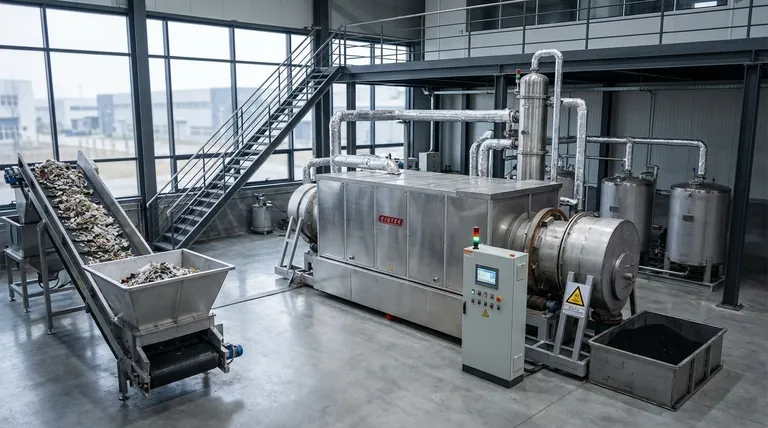At its core, the primary advantage of pyrolysis over incineration is transformation over destruction. Pyrolysis is a cleaner, more controlled process that deconstructs waste into valuable fuels and chemical products, whereas incineration simply burns waste at high temperatures, creating significant pollutants that require expensive management.
The fundamental difference is one of philosophy and outcome: Pyrolysis is a resource recovery technology that turns waste into new assets, while incineration is a waste disposal technology that destroys waste to generate heat.

The Fundamental Process Difference
To understand the advantages, you must first grasp how fundamentally different these two thermal processes are. They operate under opposing principles to achieve distinct goals.
Pyrolysis: Thermal Decomposition Without Oxygen
Pyrolysis involves heating materials to moderate temperatures, typically 350-550°C, in a completely oxygen-free environment.
Instead of burning, the heat breaks down the complex molecules within the waste into simpler, more valuable components. This process is a form of thermal decomposition, not combustion.
Incineration: High-Temperature Combustion
Incineration is the direct burning of materials at very high temperatures, often 800-1000°C, in the presence of excess oxygen.
Its purpose is complete combustion, reducing the volume of waste as much as possible while releasing a massive amount of heat.
Key Advantages of Pyrolysis
The oxygen-free, lower-temperature environment of pyrolysis gives it several distinct advantages in modern waste management.
Superior Environmental Profile
Because there is no oxygen involved, pyrolysis does not produce the harmful dioxins or nitrogen/sulfur oxides (NOx/SOx) that are common byproducts of incineration.
This eliminates the need for the complex and costly flue gas treatment systems that are mandatory for any modern incinerator, reducing both operational expense and environmental risk.
Valuable Product Creation
Pyrolysis converts waste into useful products. The output typically includes:
- Syngas: A mixture of combustible gases that can be used for energy.
- Bio-oil: A liquid fuel that can be refined further.
- Bio-char: A solid, carbon-rich material with applications in agriculture and filtration.
This transforms waste from a liability into a source of fuel and chemical feedstocks, supporting a more circular economy.
Enhanced Process Control
The operational parameters of pyrolysis, particularly temperature and duration, are more easily and precisely controlled compared to the violent combustion inside an incinerator.
This allows for fine-tuning the process to optimize the output of specific desired products (e.g., maximizing bio-oil yield).
Understanding the Trade-offs
While pyrolysis has significant advantages, it's crucial to understand the context in which each technology excels.
Incineration's Goal: Maximum Volume Reduction
Incineration's primary strength is its ability to achieve maximum waste destruction and volume reduction in a very short time. It is a mature, well-understood technology for getting rid of large quantities of waste while generating electricity from the resulting heat.
Pyrolysis's Goal: Maximum Value Recovery
Pyrolysis is not optimized for simple waste destruction; it is optimized for recovering the chemical and energy value locked within the waste. The products it creates often require additional processing or refining before they can be sold or used, which adds a layer of operational complexity.
Making the Right Choice for Your Goal
Selecting the appropriate technology depends entirely on your strategic objective for handling waste.
- If your primary focus is resource recovery and supporting a circular economy: Pyrolysis is the superior choice, as it is designed to convert waste into valuable new materials and fuels with a minimal environmental footprint.
- If your primary focus is rapid, high-volume waste disposal and direct heat-to-electricity generation: Incineration is the more established and direct pathway for destroying waste to produce energy.
Ultimately, your decision reflects whether you view waste as a problem to be destroyed or a resource to be transformed.
Summary Table:
| Feature | Pyrolysis | Incineration |
|---|---|---|
| Process Principle | Thermal decomposition without oxygen | High-temperature combustion with oxygen |
| Primary Goal | Resource recovery & value creation | Waste destruction & volume reduction |
| Typical Outputs | Syngas, Bio-oil, Bio-char | Heat, Ash, Flue Gas |
| Key Environmental Advantage | Does not produce dioxins or NOx/SOx | Requires complex flue gas treatment systems |
Ready to transform your waste into valuable resources?
KINTEK specializes in advanced laboratory equipment for pyrolysis research and development. Our solutions help you optimize processes for cleaner emissions and maximum product yield from various waste streams.
Contact our experts today to discuss how our lab equipment can support your goals in sustainable waste management and the circular economy.
Visual Guide

Related Products
- Electric Rotary Kiln Small Rotary Furnace for Activated Carbon Regeneration
- Rotary Tube Furnace Split Multi Heating Zone Rotating Tube Furnace
- Vacuum Sealed Continuous Working Rotary Tube Furnace Rotating Tube Furnace
- Laboratory Vacuum Tilt Rotary Tube Furnace Rotating Tube Furnace
- Vertical High Temperature Graphite Vacuum Graphitization Furnace
People Also Ask
- What is the temperature of a rotary hearth furnace? Find the Right Heat for Your Process
- How to regenerate activated carbon? Master the 3-Stage Thermal Process for Cost Savings
- How do you carbonize charcoal? Master the 3-Step Pyrolysis Process for High-Purity Carbon
- How is energy converted into biomass? Harnessing Nature's Solar Power for Renewable Energy
- What temperature is a carbon regeneration kiln? Master the 650°C-800°C Range for Optimal Results



















